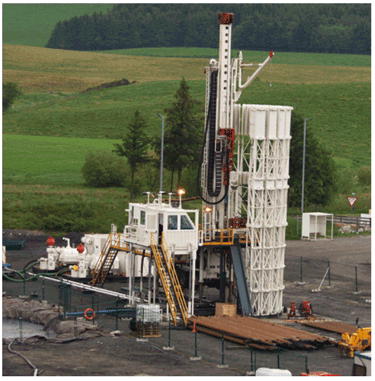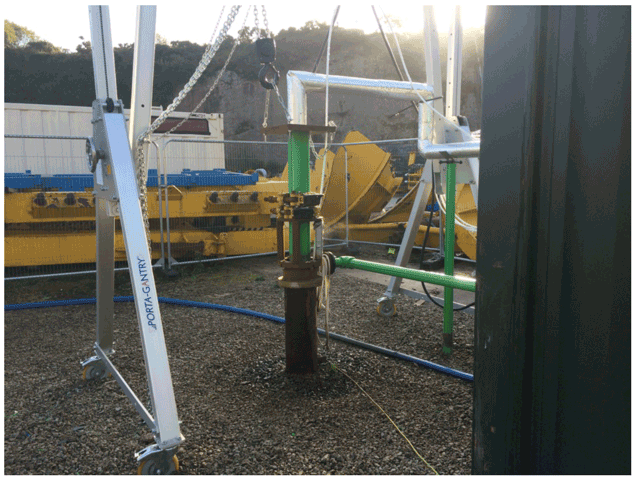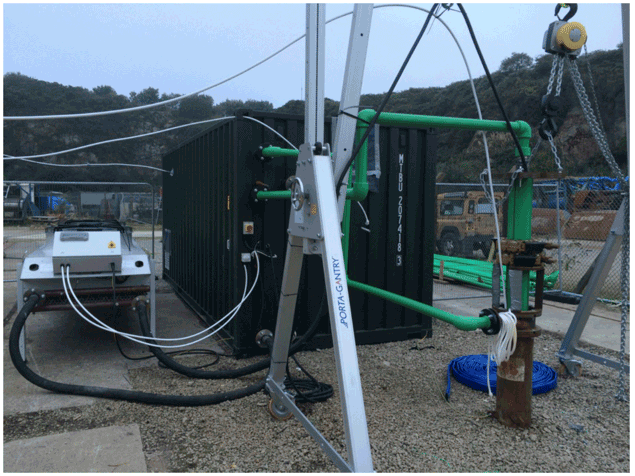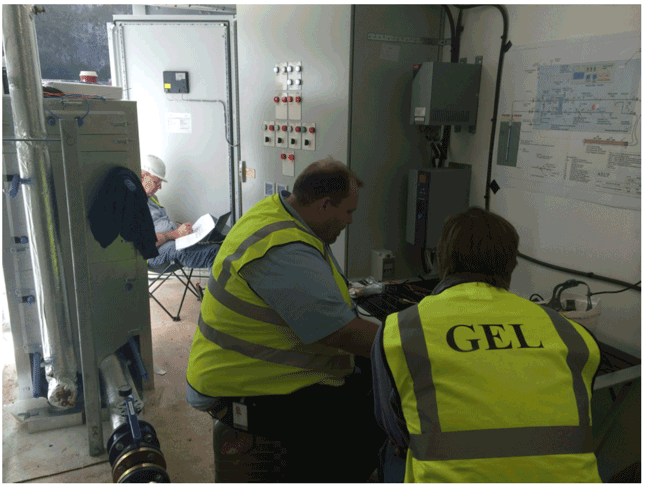Feasibility Report of a Deep Geothermal Single Well, Aberdeen Exhibition and Conference Centre
Report of study which examined the technical, logistical, contractual and economic feasibility of installing a deep geothermal single well system at the new site of the Aberdeen Exhibition and Conference Centre.
Installation Methodology
The installation of the system can be split into two principal sections:
1. Drilling and casing the well
2. Fitting the well with DGSW equipment, testing and commissioning
Drilling and Casing The Well
A 2km vertical well will be drilled at the site and cased to approximately 1,700m. The drilling contract will be structured so that the temperature can be tested at the base of the well prior to the drilling rig being removed from the site. If the temperature is not sufficient for the required delivery at the site then the rig will be sufficiently equipped to continue to drill for up to an additional 600m. For the average geothermal gradient in the UK (2.8C per 100m[47]) this represents the capacity to deliver an additional 17C of temperature contingency if required.
The drilling rig that we propose to use at the site is likely to be the Drillmec HH102 rig. This is a drilling rig that we have had experience of working with in other countries for 2km vertical wells. An example of the rig in operation is shown in Figure 15. This rig is in the United Kingdom and is available for use at the AECC site.
It is important to note that one of the benefits of the DGSW system is that the well contract can be issued and managed under an Engineering Procurement Construction (EPC) contract. This is not standard practice for oil and gas wells but, due to the simplicity of the well design, can be agreed for the DGSW (see section on contracts and insurance). The result of the EPC contract is that costs for the drilling stage of the project can be well constrained.
Figure 15: Example of the Drillmec HH102 that we propose to use at the AECC site

Drilling methodology
The proposed drilling methodology for the AECC site is outlined in the following sections:
Site Set Up
- Mobilise site perimeter hoarding to site and install around site perimeter
- Lay impermeable "nappy" membrane across site area and install collection sump for surface run-off.
- Lay timber matting across site area to protect ground from any excessive point loading
- Mobilise site welfare facilities and setup onsite i.e. welfare canteen (30 ft.), drying/change room (30 ft.) and toilet block (10 ft.)
Cellar Construction
- Mobilise heavy plant (excavators and dumpers) to site.
- Excavate and install cellar 3 no. x 1m deep x 2.1m ID concrete rings and install sleeve casing for mousehole.
- Set cellar rings in concrete and install cellar floor c/w 30" casing sleeve for commencement of conductor installation drilling
Conductor Installation
- Mobilise shallow auger drilling rig and ancillary equipment (cement grout plant etc.) onto site location
- Set-up and Auger drill from surface to +/- 20m
- Install +/- 20m of 20" J-55 API 5-CT casing and pressure cement grout in place using ordinary class C cement
- Rig down and demobilise auger rig and all ancillary equipment from site
Rig Mobilisation
- Mobilise drilling rig and all ancillary equipment onto site location
- Rig up drilling unit and layout rig and ancillary equipment configuration as per the agreed layout
- Perform rig acceptance test
- Hold tool-box talk (TBT) and pre-spud H & S meeting to ensure full understanding of the work scope requirements amongst all crew members
- Rig up riser line to the mud shaker system for cutting collection
Estimated Drilling Procedure
- Fill mud tanks and mix mud as per the mud programme and under direction from the mud engineer.
- Install 20" wellhead connector and 13 5/8" annular. Carry out pressure test.
- Make-up 14 ¾" bottom hole assembly (BHA), run-in-hole (RIH) and spud well Drill 14 ¾" to section TD (+/- 500m)
- Pull-out-of-hole (POOH) and laydown 14 ¾" BHA RIH +/- 500m of 10 3/4" J-55 API 5-CT casing, rig-up cement lines, prepare cementing equipment
- Run in hole drill pipe c/w stab in tool and cement 10 ¾" casing to surface utilizing stab in method of placement as per 3rd party supplier cementing programme
- Wait-on-cement (WOC)
- Install wellhead connector onto 10 ¾" casing and full 13 5/8" BOP stack (annular and double gate) - Function and pressure test
- RIH 9 ½" bit and drill out shoe track and float shoe
- Circulate and condition mud and perform FIT
- 27) POOH, make-up and RIH 9 ½" BHA
- 28) Drill 9 ½" to well TD of 2,000m
- 29) Rig-up wireline logging unit and run temperature and caliper logs to TD
- 30) RIH and install liner hanger system onto 10 ¾" casing at 350m and RIH +/- 1350m of 7" J-55 API 5-CT liner casing
- 31) Empty mud tanks and rig down rig and ancillary equipment
- 32) Demobilise from site rig and all ancillary equipment
Site Dismantling
- Install temporary fence around cellar for ongoing work
- Demobilise site welfare facilities from site
- Remove timber matting from site area and demobilise from site
- Remove "nappy" membrane from site area and demobilise from site. Empty site runoff from collection sump
- Take down site perimeter hoarding and remove from site
Handling and Disposal of Waste
All surplus waste materials will be moved from the work areas and disposed of by a specialist drilling waste removal company from Aberdeen.
- Site waste management plan will be in place
- All COSHH details to be retained on-site.
Testing and Commissioning
Once the well has been drilled and cased, the DGSW equipment will be installed as per the recent (2014) installation in a 2.6km well in Cornwall. The installation process will take approximately two weeks to complete, during which a standard 40 Tonne crane will be on the site at all times.
Once the equipment has been installed, the well will be tested with a Thermal Response Test rig that was designed and built by Geothermal Engineering Ltd in 2014. The rig has the capacity to extract up to 400kW of heat and test the thermal performance of the well by simulating different building demand cycles. The unit is the largest thermal response test equipment in the country (approximately 10 times larger than similar rigs) and has been built exclusively for deep geothermal single well testing. The rig and connections to the rig can be seen in Figure 18, Figure 19 and Figure 20.
Once the Thermal Response Test rig has been connected to the DGSW we will be able to test the performance of the submersible pump, the drawdown in the well under various bleed flow conditions, the nature of the geothermal fluid under abstraction / rejection at different temperatures and the thermal response of the system to various building loads. The system operation and pump control can then be optimised for use at the AECC. This testing and commissioning phase for the system will take approximately 4 months to complete.
We believe that Geothermal Engineering Ltd is uniquely positioned to undertake these types of tests and the results will be highly beneficial to both ensuring the optimum performance of the well at the site and to assisting the development of deep geothermal energy in Scotland as a whole.
Figure 16: Completed well-head connections to the Thermal Response Test unit

Figure 17: Thermal Response Test unit and connected energy abstraction fans

Figure 18: Thermal Response Test unit showing heat exchanger and central control panel

Contact
Email: Johann MacDougall
There is a problem
Thanks for your feedback